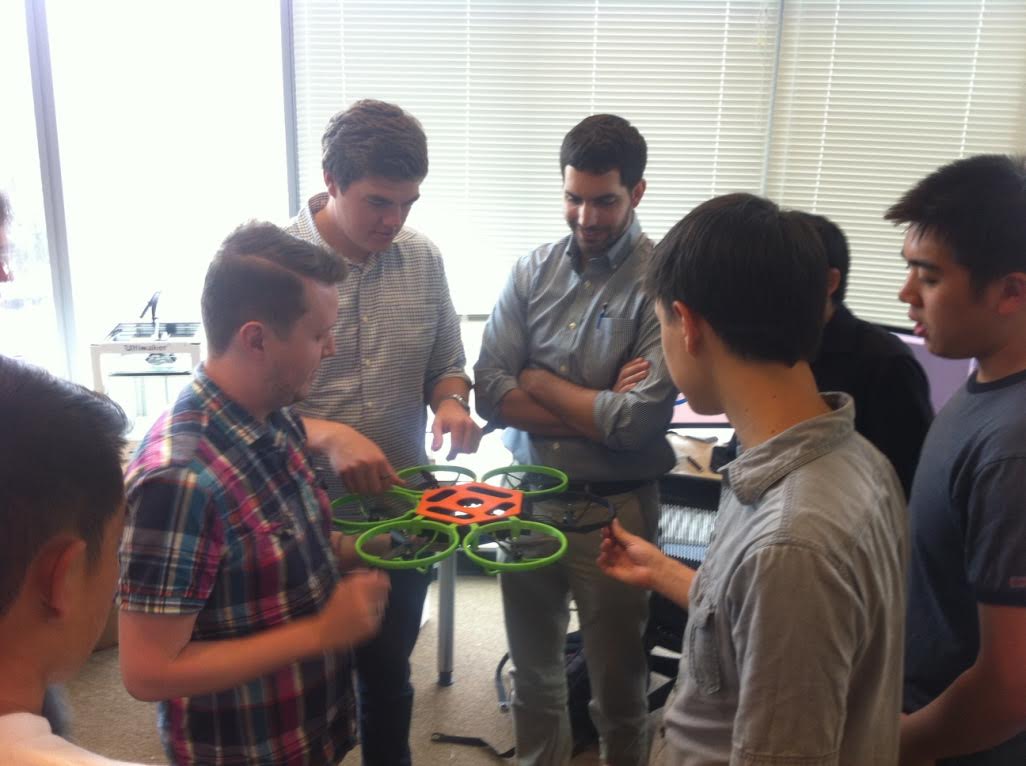Not Just a Plastic Paperweight: Using 3D Printers to Take to the Sky
San Diego, Calif., July 28, 2015 —The student-driven 3D Printable Robotics class, taught by Structural Engineering and Computer Science and Engineering Professor Falko Kuester, teaches students the inner-workings of 3D printing at a graduate level. With only three weeks of instruction in hand, the students were already designing, modeling and printing initial prototypes on Fused Deposition Modeling (FDM) printers, learning the tricks of the trade firsthand.
The nine students in the class channeled a multitude of disciplines – structural, mechanical and aerospace engineering – to form a single project idea for the spring quarter. They initially broke off into three groups, each intending to develop its own project. Funny enough, however, the brainstorming of each group all landed them with the same idea: to build a drone.
They didn’t want to build your average soaring-through-the-sky drone, though, but one that would use its airborne capabilities to collect data and in turn use that data to tell a story. Their idea was to operate the drone to take 2D images of monuments and important sites, which they would then manipulate and recreate into 3D visual images, thus using a simple piece of hardware to tackle a high-tech operation.
With all nine heads working together, the students brought their ideas down to a realistic level and decided to form one large group but split off into three subgroups to increase the possible complexity of the drone. The superstructure team was in charge of building the central hub, while the propulsion team was in charge of regulating the efficiency of the propellers. The third team was in charge of designing the controls, sensor package and autopilot.
“If one of the components is off, nothing fits or works as planned, so there have to be constant communications within the team and subteams. In the end, the final system matters,” said Kuester.
The end product? Ownership and a taste of what it’s like to work in the real world (well, aside from the drone of course). “With each group having their own responsibilities, we simulated the environment of a large engineering company,” said teaching assistant James Strawson, a PhD student and IGERT-TEECH trainee focussing on robotics research.

To keep the design as straightforward as possible, the team created a modular hexa-copter – one with six rotors – with snap-together parts. Simplifying the process even further, the design was broken up into modular parts, all of which snap onto the central hub.
The central hub holds the drone’s brain, a single-board computer paired with a robotics cape that is not dissimilar in size and capabilities from an everyday cell phone. The robotics cape, a C-programmable daughter board (which is smaller than a motherboard), was developed by Strawson and used for drone control and data collection.
Connected to the bottom of the central hub – which has both vertical and horizontal connections – are a pair of arms, serving as both a the landing gear and grabber mechanism, allowing the drone to attach itself to different surfaces such a rooftops or cables.
The team then moved on to the fun part – developing their creation using the 3D printers. The team spent numerous hours designing, modeling, simulating, 3D printing, testing and refining the drone components before finally landing on the perfect design. The end product used their favorite material, PLA (polylactide) – a cheap, biodegradable plastic material that prints smoothly and was an easy choice when assessing the weight of the drone.
“We had to make sure that the drone wasn’t too heavy,” said Alex Timmerman, who graduated from the Structural Engineering Department this year. “We had a certain amount of thrust, and we had to ensure that the drone’s weight didn’t require too much percentage of that thrust.”
Using consumer-level Ultimaker2 FDM printers (which print in one-millimeter layers), it took the team four hours to print each duct and eight hours for the central hub. The students brought out the big guns – the 3DP Unlimited X1000 – for larger parts or collections of parts.
So why use 3D printing to build the drone? “We wanted to introduce 3D printing as a manufacturing technique and not just an engineering one,” says Timmerman.
3D printing also added an interesting element to the process, challenging the students to not just print a handy paperweight but a functional system. “Suddenly it’s not just about the design, modeling and simulation, but now you have to build and test it,” says Kuester.
“For me the key thing is the integrative design philosophy,” he continues. We start with a model and build the physical artifacts and then we analyze, test and learn from it and then do it again. With every iteration you evolve your approach. In many cases it’s a cumulative design experience. You have to take everything you’ve learned about structural design, modeling and analyzing and reach deep into your toolbox. It’s a hands-on, experience-based learning process.”
Though the drone is still in the process of being tested, the students are already looking at more complex uses for the machinery. “We want to enable and further empower them, while keeping those creative juices flowing. That’s really the fun,” says Strawson. "Who knows, maybe next year UC San Diego students will be spotting even larger plastic objects whizzing away in the sky.
Related Links
Falko Kuester (faculty profile)
Media Contacts
Tiffany Fox, (858) 246-0353, tfox@ucsd.edu
